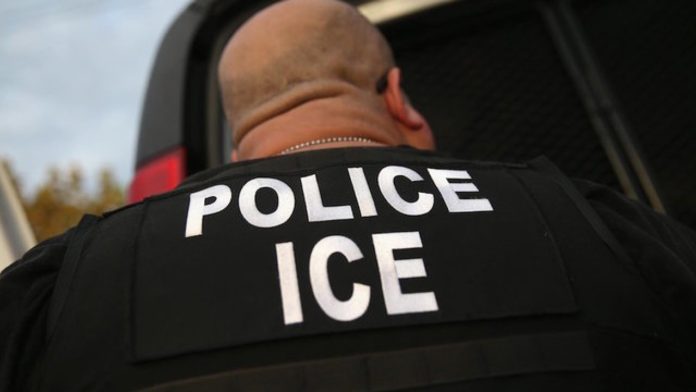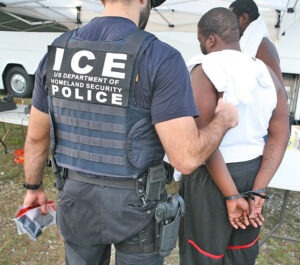
This week, the ACLU—along with the ACLU of Florida, the Southern Poverty Law Center, and Gibson, Dunn & Crutcher LLP—filed a lawsuit against the Monroe County Sheriff’s Office on behalf of Peter Sean Brown, a U.S. citizen who had been working at Mango’s in Key West. Brown reported a harrowing experience, being taunted by officers at Monroe County Detention Center and ultimately threatened deportation to Jamaica, a country he has only visited once. Brown insisted he was a citizen — he was born in Philadelphia — and was transferred to a federal detention center in Miami, where, 12 hours later, he was released. Brown’s written complaint was met with, essentially, a message that the sheriff’s hands were tied: “Mr. Brown, You are being held on a felony VOP and an ICE hold. It is not up to us to determine the validity of the ICE hold. That is between you, your attorney, and ICE.”
Sheriff Rick Ramsay’s office responded in a press release to the breaking news of the lawsuit. “Local law enforcement throughout this country has been caught in the middle of a political argument regarding immigration,” said Ramsay. “This was an unfortunate case of mistaken identity by ICE regarding a subject who was initially in state custody for violating probation.”
Brown was arrested on a VOP—violation of probation—for a misdemeanor marijuana offense, and his original charge was for a felony crime of violence against a police officer. After the VOP arrest, the Monroe County Sheriff’s Office received an order from the Department of Homeland Security to detain Brown for ICE to pick him up. According to the Basic Ordering Agreement (BOA) between the Sheriff’s Department and ICE, Ramsay’s officers have to detain people in custody who have been earmarked by ICE as undocumented immigrants. Technically, Ramsay would have been breaking federal law by releasing Brown.
In January, ICE announced 17 BOAs with sheriffs throughout Florida. U.S. Immigration states that when “an alien is arrested on a local criminal charge, all too often, they are subsequently released before ICE has the opportunity to pick them up.” So, ICE is using local law enforcement to detain and house people whose identities are flagged in the Homeland Security database. All sheriffs’ departments, including Monroe County, have computers connected to federal agencies. Adam Linhardt, director of media relations at the Monroe County Sheriff’s Office, said, “When you get processed in our jail, we run your fingerprints, and the FDLE (Florida Department of Law Enforcement) runs them, and shares them with national law enforcement, like the FBI, ICE, etc., so that we’re on the same page of who’s being detained where and for what.”
Cross-referencing makes sense, but why were Ramsay’s hands tied when it came to releasing someone provably a U.S. citizen? That’s where the BOA comes back in—The sheriff’s office does not have jurisdiction, only custody, of someone who is being held at a partnering facility (the Monroe County Jail) by ICE, even if, theoretically, the detainee presented a birth certificate, a passport, and his mother.
Linhardt explains the context of ICE detainees at the Monroe County Jail: “ICE detainees are in two columns, and the first column is an initial agreement, which goes back to the 1990s.” This agreement, negotiated between the sheriff’s office and ICE directly, dictates that the sheriff’s office will house ICE detainees (generally undocumented immigrants) and for that, the county receives $87 a day, per detainee. Linhardt made it clear that he was not explaining the rules in reference to the Brown case, but rather ICE detainees held under “column one” — regular ICE detainees. He said, “The rules for those folks are different, because they aren’t here on a crime, exactly; they are being held here for immigration-related issues. They are to be held separately from a general population, and there are some different regulations for them.” Food, recreation and medical care are similar, but they might have different allowances for clothing, packages they can receive and so forth. There are 50 to 60 ICE detainees at the Monroe County Jail at any given time.
When ICE entered into BOAs with different municipalities in January, that is what Linhardt calls “the second column.” He said, “This relates to folks who are in custody, in jail, for some reason, most often at the state level.” While Linhardt doesn’t specify this, the second column is the column Brown falls under. Brown was held in General Population, because he was in the jail for a VOP, but the ICE hold meant the Monroe County Sheriff’s Department couldn’t release him. Even if he proved he was a citizen? Even so.
Homeland Security sent the Sheriff’s Office an order from a federal judge, claiming, via “biometrics” (fingerprints), that Brown was an “alien,” having been born in Jamaica in 1968. Of course, now we know that was incorrect, and we can reasonably conclude that the officers at the jail also could access records indicating that Brown was born in the U.S., but a release would go against the written order of a federal judge. In the press release, Ramsay wrote: “Though the Sheriff’s Office does not investigate immigration matters, and while I cannot release detainees under ICE custody, I immediately took action when notified of this matter months ago. I ordered Sheriff’s Office detention deputies to immediately notify ICE of a detainee’s claims of citizenship and to follow up with those claims.”
According to the BOA, the Sheriff’s Office can only hold an ICE detainee for 48 hours before they are released. In the case of Brown, he was technically still in custody for the VOP, and when transferred to Miami, his ICE clock started ticking (he was released after 12 hours). The question remains: what details of Brown’s criminal case required him to remain in jail for weeks, other than the ICE hold?
Unlike the detainees in “column one,” Monroe County only receives $50 for each detainee released to ICE under the 2018 BOA, and the money goes directly to the county—not the sheriff’s office. When the BOA came about, Ramsay declined being cross-deputized as a federal and county agent, preferring to stick to local law enforcement rather than pursuing federal matters. Now, he’s in the hot seat despite it.
Linhardt describes “the second column” detainees (inmates in the general population who are also under an ICE hold) as “really rare.” The population of people in “column one” who often have no criminal history are held separately and that population changes often, as ICE brings in and takes away detainees. But it seems to be a legal quagmire when a county jail is essentially serving as a contractor for a federal agency, and then is sued for its inaction when the federal agency erred. Linhardt declined to comment directly on the Brown case.




















